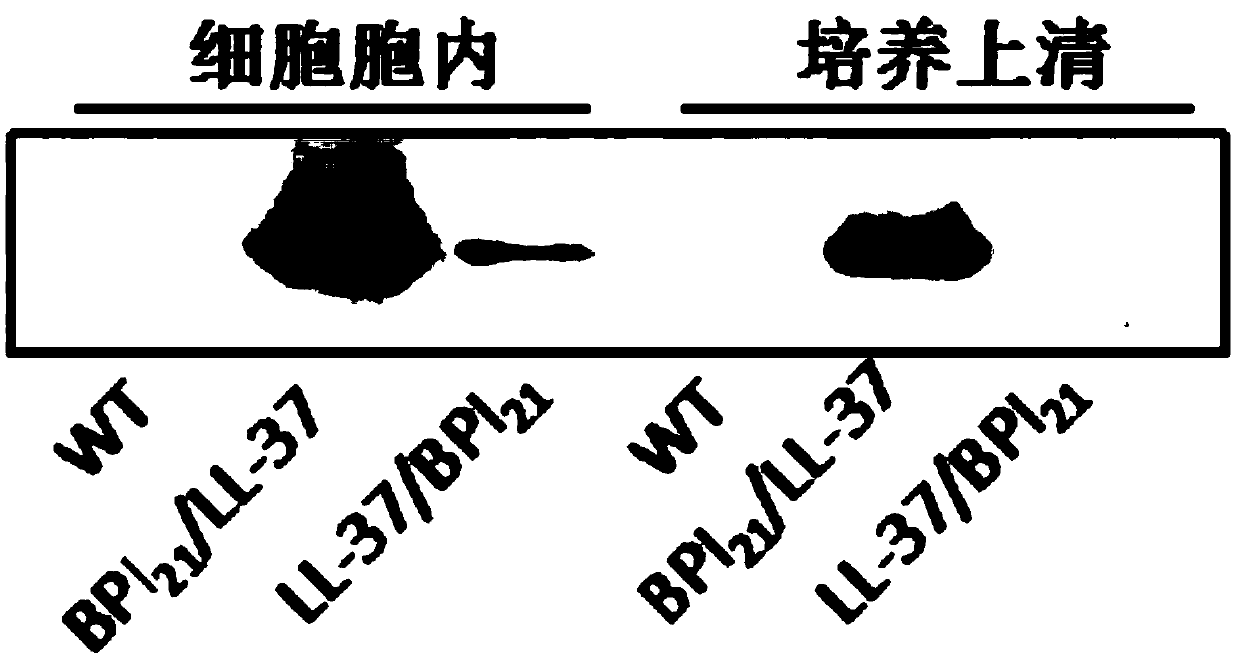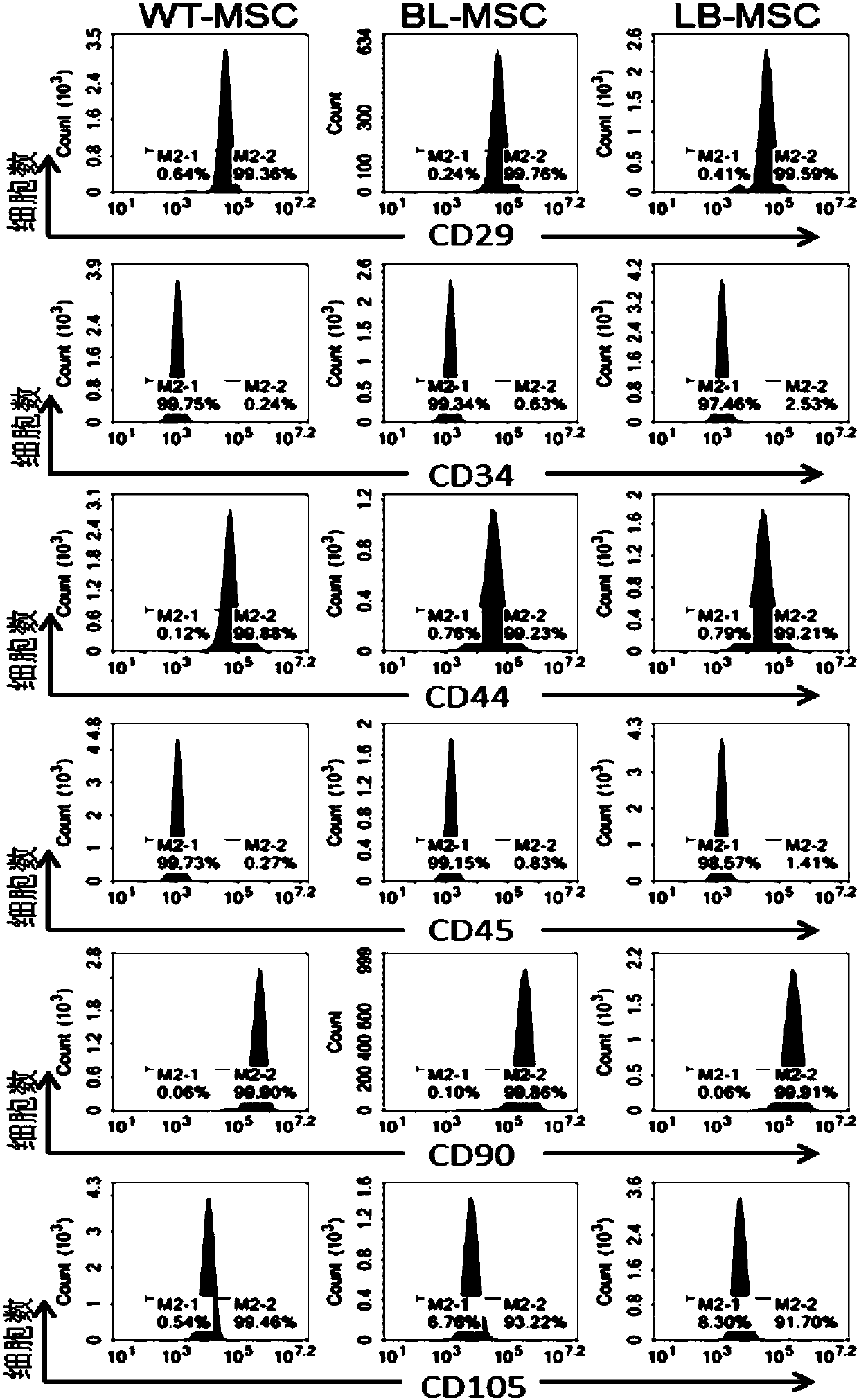Mesenchymal stem cells with enhanced antimicrobial function as well as application of mesenchymal stem cells in sepsis
A technology of stem cells and antibacterial peptides, applied in the field of construction and its application in sepsis, can solve the problems of difficulty in achieving antibacterial, anti-endotoxin and anti-inflammatory effects, weak functions, etc., and achieve enhanced neutralization of endotoxin. ability, enhance antibacterial effect
- Summary
- Abstract
- Description
- Claims
- Application Information
AI Technical Summary
Problems solved by technology
Method used
Image
Examples
Embodiment 1
[0038] Example 1 Structure of expression vectors of pLVX-rBPI21-LL37 and pLVX-LL37-rBPI21
[0039] According to the amino acid sequence of the antibacterial fusion protein and the preferred codon of Chinese hamster, the fusion protein gene was designed and synthesized, and the synthetic gene was cloned into the pLVX-Tight-Puro vector to construct the fusion protein expression vector. Finally, two forms of fusion protein gene expression vectors, BPI21-LL37(BL) or LL37-BPI21(LB), were obtained. The difference between the two expression vectors is that the order of fusion is different, and the signal peptide of each protein located at the N' end guides the exocrine expression of the entire fusion protein. The schematic diagram of the construction of the vector is as follows figure 1 as shown, figure 1 A is the schematic diagram of the vector structure of pLVX-rBPI21-LL-37, figure 1 B is the structural representation of pLVX-LL-37-rBPI21 vector.
Embodiment 2
[0040] Example 2 Western Blot detection of rBPI21 / LL-37 antibacterial fusion protein expression
[0041] (1) Packaging of lentivirus
[0042] The cultured 293FT cells were digested with trypsin, the growth medium was discarded, and the cells were resuspended in the lentiviral packaging medium to make a cell suspension. The cells were counted and the concentration of the cell suspension was calculated. Take 1×10 5 / cm 2 Cells were seeded into 10 cm culture dishes at a density of . According to the liposome transfection method, add 3 μg lentiviral vector (pCDH), 3 μg pLP1, 3 μg pLP2, 3 μg pLP / VSVG to 1.5 ml serum-free DMEM basic medium, and shake gently to mix. Add 36 μl lipofectamine transfection reagent to 1.5 ml serum-free. Slowly add the liposomes to the plasmid mixture, mix gently and let stand at room temperature for 20 minutes until the DNA / liposome complexes are formed. Add all the DNA / liposome complexes to the 293FT cells, make up the medium to 10ml, gently pipette...
Embodiment 3
[0055] Example 3 Detection of stemness maintenance of BL-hUC-MSCs and LB-hUC-MSCs
[0056] Stemness maintenance plays a very important role in the function of mesenchymal stem cells. After lentivirus infection of the 4th passage umbilical cord-derived mesenchymal stem cells, flow cytometry was used to identify cell surface molecular markers and detect BL-hUC-MSCs And the change of stemness of LB-hUC-MSCs.
[0057] The result is as image 3 As shown, the results of flow cytometry showed that after lentivirus infection, the positive rates of CD29, CD44, CD90, and CD105 and the negative rates of CD34, CD45 on the surface of hUC-MSCs were in line with the standards recommended by the International Society for Cell Therapy (ISCT) in 2006, which indicated that Lentivirus infection had no significant effect on the stemness maintenance of mesenchymal stem cells.
PUM
 Login to View More
Login to View More Abstract
Description
Claims
Application Information
 Login to View More
Login to View More - R&D
- Intellectual Property
- Life Sciences
- Materials
- Tech Scout
- Unparalleled Data Quality
- Higher Quality Content
- 60% Fewer Hallucinations
Browse by: Latest US Patents, China's latest patents, Technical Efficacy Thesaurus, Application Domain, Technology Topic, Popular Technical Reports.
© 2025 PatSnap. All rights reserved.Legal|Privacy policy|Modern Slavery Act Transparency Statement|Sitemap|About US| Contact US: help@patsnap.com



